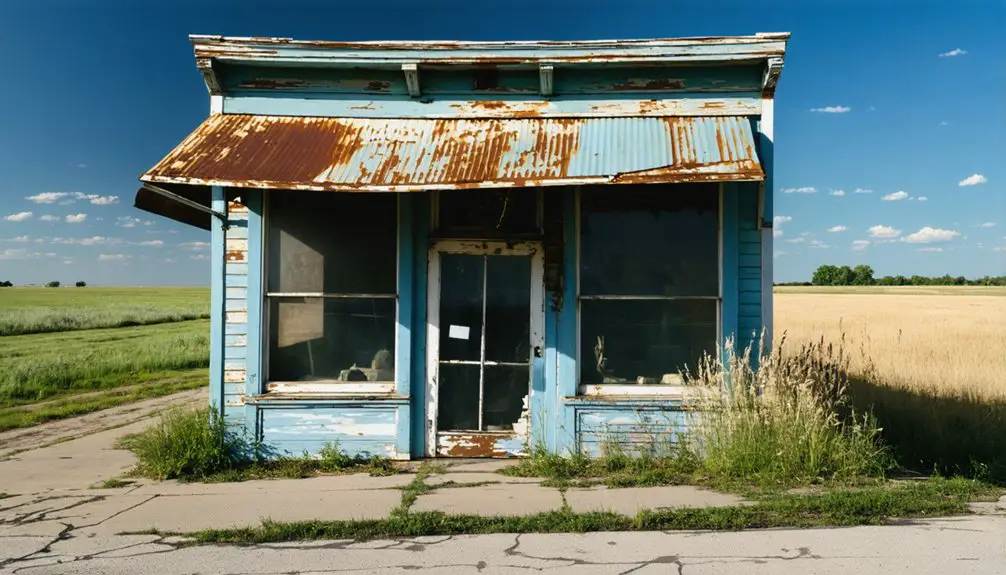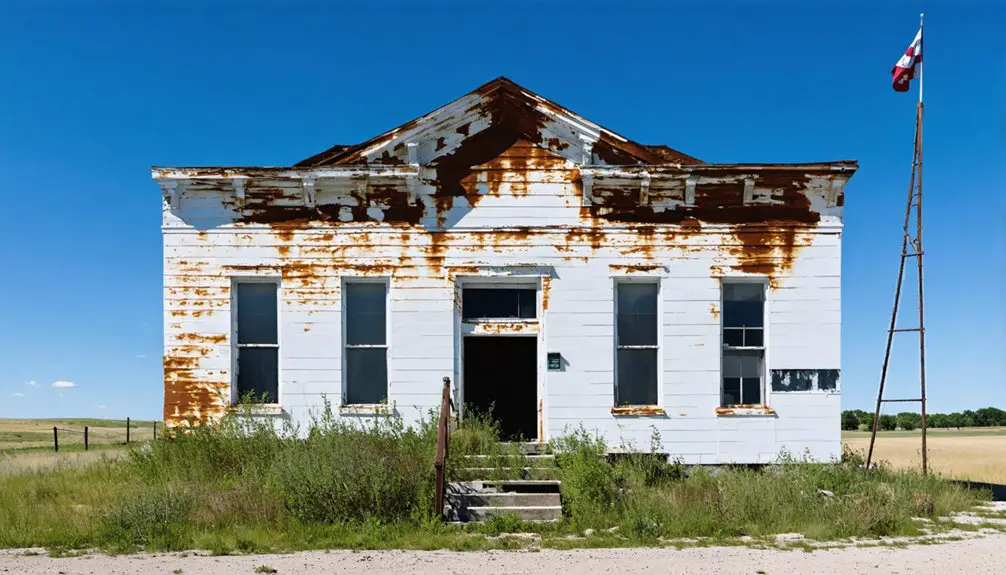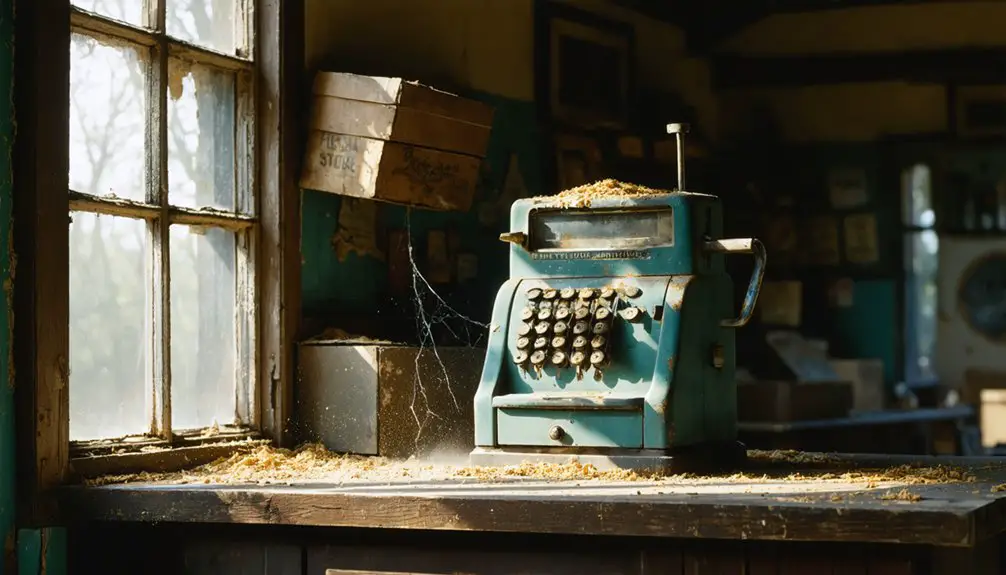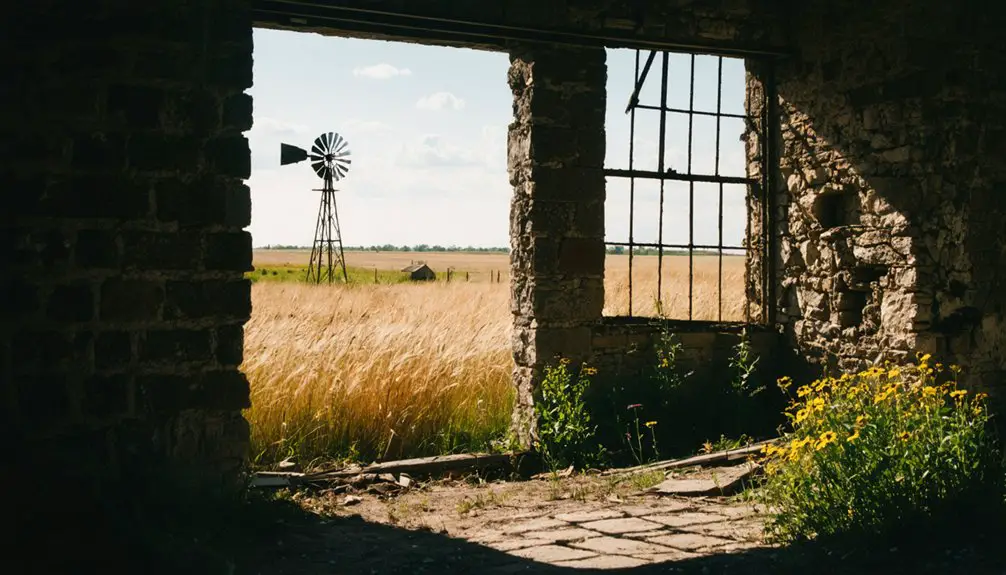You’ll find Leota’s haunting remains in Wichita County, Kansas, where this 1885 frontier settlement once thrived with about 100 pioneers. Named after M.A. Morrison’s daughter Leoti, the town featured a general store, hotel, and busy stagecoach stop. A violent county seat war with Coronado in 1887 led to multiple deaths, marking the beginning of Leota’s decline. Beyond its weathered foundations lies a tale of ambition, conflict, and frontier dreams gone dark.
Key Takeaways
- Leota was established in 1885 as a frontier settlement in Wichita County, Kansas, initially housing around 100 pioneering residents.
- The town featured essential businesses including a general store, hotel, blacksmith shop, grist mill, and post office serving stagecoach travelers.
- A violent shootout on February 27, 1887, during the county seat rivalry with Coronado marked a turning point in Leota’s history.
- Severe droughts in the late 19th century caused widespread crop failures, forcing many homesteaders to abandon their farms.
- The town’s decline accelerated due to economic stagnation, lack of railroad access, and population shifts, eventually becoming a ghost town.
Origins and Early Settlement Days
As settlers pushed westward across Kansas in the late 19th century, Leota emerged as a promising frontier settlement in 1885. You’d have found a determined group of pioneers from Garden City leading the charge, establishing their stake in Wichita County’s prairie landscape at coordinates 38°29′00″N 101°21′28″W. Like many Kansas towns that followed, Leota’s pattern mirrored communities such as Clonmel and Peck, which relied heavily on agricultural activities.
The settlement patterns reflected typical western expansion, with early governance taking shape through community action. You would’ve witnessed the founders’ ambitious drive as they campaigned to make Leota the county seat, raising funds and petitioning the Kansas governor. The town’s quest for county seat status ended in a tragic bloody shoot-out on February 27, 1887, that claimed multiple lives.
The People Behind Leota’s Name
You’ll find several competing theories about how Leota got its name, with some locals claiming it honors Leoti Gray, the daughter of town founder M.A. Morrison.
A second tradition suggests the name comes from early settler Leoti Kibbee, while yet another points to Native American origins, translating Leoti as “prairie flower.”
While definitive documentation remains elusive, these origin stories reflect the intertwined influences of settler families and indigenous heritage in shaping the town’s identity. Located just five miles from Norton, the town was strategically positioned to serve the surrounding agricultural community. Like many Kansas settlements of its era, Leota’s ultimate fate was sealed when the railroad bypassed the town.
Competing Origin Stories Exist
The origins of Leota’s name remain shrouded in competing narratives that have persisted through generations.
Historical documentation points to Leoti Gray, daughter of a prominent founder who married Henry Kibbe, as the namesake. This aligns with regional naming patterns, where other Kansas towns honored women settlers or founders’ daughters. Like many communities that experienced economic downturns, Leota’s population dwindled during the harsh years of the Dust Bowl.
Yet oral traditions suggest a different story, claiming the name derives from a Native American term meaning “prairie flower” – a tribute to the region’s natural heritage and indigenous roots.
You’ll find that some local histories reference Leoti Kibbee as the inspiration, though this account likely stems from a conflation with the Leoti Gray narrative.
While historical records lean toward the settler family origin, the true source remains debated among historians and locals alike.
Morrison Family Connection
While previous accounts debated Leota’s namesake, definitive records show that M. A. Morrison, one of the town’s founders, named the settlement after his daughter Leota. This Morrison heritage became permanently etched in Kansas history when postal regulations forced a name change from the original “Weston” designation.
The family’s influence extended well beyond just naming rights:
- M. A. Morrison actively guided the town’s development through platting and filing in 1879.
- The Morrisons spearheaded Leota’s bid to become Norton County’s seat during 1875-1878.
- Their New England roots represented the westward expansion of Anglo-American settlers.
- Multiple generations of Morrisons, including Riley Delbert Morrison, maintained the family’s presence in Leota Township. Today, descendants can trace their Morrison lineage through family history records on genealogy websites.
The Morrison legacy remains a reflection of the pioneering spirit that shaped Kansas’s early settlements. After losing the county seat contest, Leota shifted its focus to become a trading center like Oronoque.
Native American Name Theory
Despite the established Morrison family connection, competing theories suggest Native American origins for Leota’s name, particularly its interpretation as “prairie flower” in tribal languages.
You’ll find this Native symbolism reflected in Kansas’s broader pattern of place names honoring indigenous heritage, though pinpointing the exact tribal source remains challenging.
The cultural significance of such naming practices often stemmed from early settlers’ interactions with local tribes like the Kansa, Shawnee, and Osage. Similar to how nineteen tribal streets were incorporated into Leavenworth’s layout, these indigenous influences shaped local nomenclature.
Modern interpretations link the name to the one who is loved, reflecting its documented Native American meaning.
While historical records offer conflicting explanations, the name’s possible connection to nature aligns with traditional Native American naming customs that emphasized strength, resilience, and ties to the land.
This interpretation adds another layer to Leota’s complex identity, even as definitive proof of its Native origins remains elusive.
Life in a Frontier Prairie Town
Living in Leota during the late 1870s meant adapting to harsh prairie conditions while building a frontier community from scratch.
Early settlers like M.A. Morrison faced frontier challenges that tested their resolve daily. Similar to the Kickapoo and Potawatomi tribes who previously inhabited frontier regions, you’d find yourself among roughly 100 pioneering neighbors, living in either wooden frame or sod houses while working to establish essential services.
Life in Leota centered around:
- Agriculture and trade work – farming, milling, blacksmithing, and wagon-making
- Weekly stagecoach arrivals bringing mail and supplies from 55 miles away
- Religious gatherings at Methodist and Presbyterian churches
- Political tensions from ongoing county seat rivalries
You’d spend your days working alongside tradesmen, attending church services, and participating in heated civic debates that would ultimately shape the town’s destiny.
Commerce and Community Services

If you’d visited Leota’s main street in the late 1870s, you’d have found a bustling frontier town with a general store, hotel, mills, and various professional services including a lawyer and physician.
Local craftsmen, particularly the blacksmith and wagonmaker, kept the town’s essential transportation and farming equipment in working order.
The town’s Methodist and Presbyterian churches, along with its district school, formed the social backbone of the prairie community, bringing settlers together for worship, education, and community gatherings.
Bustling Main Street Businesses
The bustling streets of 1870s Leota offered residents essential services and commerce through a diverse array of businesses.
You’d find a vibrant local economy centered around Main Street businesses that served the town’s growing population of 100 residents.
If you were to walk down Leota’s main thoroughfare in its prime, you’d discover:
- A prominent general store stocking frontier necessities
- A busy hotel catering to stagecoach travelers
- A skilled blacksmith and wagonmaker supporting local agriculture
- A grist mill processing grain from surrounding farms
You’d also encounter J.W. Cope’s post office, receiving mail four times weekly via stagecoach, and a practicing physician tending to the community’s medical needs.
These establishments formed the backbone of Leota’s commercial district until its eventual decline in 1882.
Local Trades and Professions
While Leota’s Main Street bustled with retail activity, a diverse network of skilled tradespeople and professionals formed the backbone of daily frontier life.
You’d find blacksmiths perfecting their craftsmanship techniques at the forge, while carpenters and wheelwrights kept the town’s buildings and wagons in working order. Local trade apprenticeships guaranteed these crucial skills passed to the next generation.
Beyond traditional craftsmen, you could rely on fundamental service providers like physicians, teachers, and clergy members who strengthened the community’s social fabric.
The town’s livelihood depended on agricultural support services – grain millers, implement dealers, and livestock traders.
Communication flowed through the post office and telegraph operators, while transportation services like livery stables and stagecoach lines kept you connected to neighboring settlements.
Churches and School Life
Spiritual life in Leota centered around two prominent churches by 1878 – the Methodist and Presbyterian congregations – which served as more than just places of worship.
These institutions formed the backbone of community gatherings and moral guidance while supporting local educational priorities.
You’ll find that church functions and schooling were deeply intertwined with daily life in this frontier town.
The establishment of a district school demonstrated the settlers’ commitment to their children’s future, serving around 100 residents at its peak.
Here’s what made these institutions essential:
- Churches hosted social events and community meetings
- The school provided crucial education in literacy and arithmetic
- Religious leaders supported educational initiatives
- Both institutions attracted settler families to the area
Sadly, these pillars of community life declined as Leota lost the county seat battle, with most activities shifting to Norton by 1882.
The Battle for County Seat Status

Following its founding in 1885, Leoti found itself embroiled in a fierce battle for county seat status with rival town Coronado after Wichita County’s establishment in 1886.
You’d have witnessed intense competition between the two communities, as both knew the economic prosperity that would come with being named county seat.
The rivalry reached its bloody peak on February 27, 1887, when a violent confrontation erupted between men from both towns, resulting in multiple deaths and injuries.
While a scheduled election had taken place earlier that month, controversy over voter turnout led to demands for a re-election.
Ultimately, Leoti secured the coveted position, while Coronado’s population dwindled until the town was completely abandoned, leaving only farmland where a once-promising settlement had stood.
Transportation and Mail Routes
The arrival of the Missouri Pacific railroad in July 1887 marked a new chapter in Leoti’s development, coming just months after the bloody county seat battle.
The railroad’s arrival in Leoti brought new possibilities to a town still healing from its violent county seat struggle.
You’d find impressive infrastructure including a large depot, extensive stockyards, and freight capacity that surpassed neighboring towns.
Despite early promise, transportation challenges and limited investment hindered Leoti’s growth.
Here’s what you’d discover about the town’s rail and mail service:
- The Santa Fe railroad began regular service by January 1888, equipped with ticket offices and telegraph facilities.
- Mail routes shifted from overland to rail delivery, dramatically improving communication speed.
- Local wheat and cattle shipments supported modest commerce.
- A failed 1908 Missouri Valley Railroad expansion to Colorado marked declining transport opportunities.
These limitations ultimately contributed to Leoti’s isolation and economic stagnation.
The Town’s Rapid Decline

While Leota initially showed promise as a frontier settlement, devastating droughts in the late 19th century triggered a rapid spiral of decline.
You’d have witnessed severe economic struggles as crop failures forced homesteaders to abandon their farms, seeking more viable lands elsewhere. The town’s fate was further sealed when it lost the contentious 1886 county seat election to Coronado amid voting irregularities, diminishing its political importance and commercial appeal.
Population shifts accelerated as businesses shuttered and remaining settlers moved to more prosperous communities.
Without a railroad connection or major transportation routes, Leota couldn’t sustain its economic base. The exodus of residents, combined with limited agricultural prospects and fractured community spirit, transformed this once-hopeful frontier town into another Kansas ghost town.
Legacy in Kansas Settlement History
As one of countless Kansas settlements that emerged during the 1870s frontier expansion, Leota offers valuable insights into the era’s town-building dynamics and settlement patterns.
The town’s historical significance lies in how it exemplifies both the promise and economic challenges faced by frontier communities.
You’ll find Leota’s story particularly compelling through these key aspects:
- The fierce competition for county seat status reveals the intense rivalry between emerging settlements.
- The town’s strategic location on Prairie Dog Creek demonstrates how water access influenced early development.
- The diverse mix of businesses and services shows the self-sufficiency frontier towns needed.
- The ultimate removal of buildings to other locations illustrates how railroad routes could make or break a settlement’s future.
Leota’s legacy serves as a reflection of the volatile nature of frontier development and the pursuit of opportunity in early Kansas.
Frequently Asked Questions
Are There Any Surviving Photographs of Leota During Its Active Years?
You won’t find any surviving photographs of Leota’s active years in ghost town photography collections. While there’s related historical imagery from nearby Coronado, Leota’s brief history lacks direct photographic documentation.
What Happened to the Cemetery and Burial Records From Leota?
Like scattered leaves in autumn wind, you’ll find cemetery preservation records have vanished – no distinct burial records survive. The cemetery’s exact location and documentation were lost to time’s relentless march.
Did Any Notable Crimes or Outlaws Make Headlines in Leota?
You won’t find major outlaw legends or crime stories from Leota itself. Don’t confuse it with Leoti, which made headlines for its violent 1887 county seat war that turned deadly.
What Were Typical Land Prices for Leota Lots During Its Peak?
You’d have found lots during Leota’s economic growth years (1885-1890) selling from a few dollars up to perhaps $50, though exact land values weren’t well documented in this frontier boomtown.
Were There Any Known Native American Conflicts Around Leota’s Settlement?
While major Native American tribes had left western Kansas by 1880, you’ll find no documented conflicts specifically around Leota’s settlement. The area’s last tribal presence ended decades before development began.
References
- https://lostkansas.ccrsdigitalprojects.com/sites/lostkansas/files/private_static/2022-12/LT_WH_Coronado_Harkness.pdf
- https://legendsofkansas.com/norton-county-kansas-extinct-towns/
- https://en.wikipedia.org/wiki/Leoti
- https://www.youtube.com/watch?v=Td_gmiDMfI4
- https://www.wichitacountymuseum.org/wichita_rr_history.htm
- https://www.youtube.com/watch?v=VPZtNoncnig
- https://www.youtube.com/watch?v=alC1wDdSVvg
- https://www.wikiwand.com/en/articles/Farmer_City
- https://www.geotab.com/ghost-towns/
- https://esirc.emporia.edu/bitstream/handle/123456789/1309/Cover Vol 4 Num 4.pdf?sequence=4



